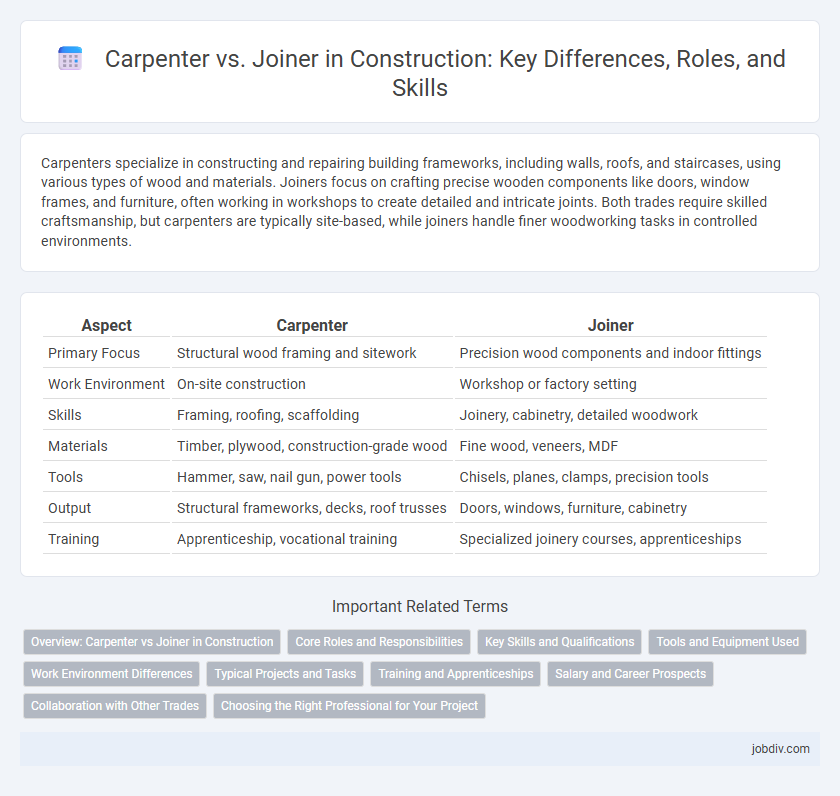Carpenters specialize in constructing and repairing building frameworks, including walls, roofs, and staircases, using various types of wood and materials. Joiners focus on crafting precise wooden components like doors, window frames, and furniture, often working in workshops to create detailed and intricate joints. Both trades require skilled craftsmanship, but carpenters are typically site-based, while joiners handle finer woodworking tasks in controlled environments.
Table of Comparison
| Aspect | Carpenter | Joiner |
|---|---|---|
| Primary Focus | Structural wood framing and sitework | Precision wood components and indoor fittings |
| Work Environment | On-site construction | Workshop or factory setting |
| Skills | Framing, roofing, scaffolding | Joinery, cabinetry, detailed woodwork |
| Materials | Timber, plywood, construction-grade wood | Fine wood, veneers, MDF |
| Tools | Hammer, saw, nail gun, power tools | Chisels, planes, clamps, precision tools |
| Output | Structural frameworks, decks, roof trusses | Doors, windows, furniture, cabinetry |
| Training | Apprenticeship, vocational training | Specialized joinery courses, apprenticeships |
Overview: Carpenter vs Joiner in Construction
Carpenters in construction primarily work on structural elements such as frameworks, roofs, and scaffolding, focusing on rough and load-bearing tasks. Joiners specialize in crafting detailed woodwork like doors, windows, stairs, and furniture, emphasizing precision and finish. Both roles require advanced woodworking skills but differ in scope, with carpenters handling larger-scale construction and joiners concentrating on fine, interior components.
Core Roles and Responsibilities
Carpenters specialize in framing, rough construction, and structural work, including installing frameworks, doors, and windows on-site, while joiners focus on crafting detailed woodwork such as staircases, cabinetry, and furniture in workshops. Carpenters handle larger-scale construction projects requiring precision and strength, whereas joiners create intricate, fine joinery requiring expert woodworking skills. Both professions demand knowledge of materials, tools, and techniques but differ primarily in the setting and complexity of their wood fabrication tasks.
Key Skills and Qualifications
Carpenters require proficiency in interpreting blueprints, using hand and power tools, and constructing frameworks with precision. Joiners specialize in crafting detailed woodwork such as doors, window frames, and furniture, demanding advanced skills in fine woodworking and finishing techniques. Both roles benefit from vocational training or apprenticeships, with carpenters often emphasizing structural knowledge and joiners focusing on decorative and intricate wood joinery.
Tools and Equipment Used
Carpenters primarily use tools such as saws, hammers, chisels, and power drills for framing, roofing, and rough construction tasks, emphasizing durability and speed. Joiners focus on precision tools like planes, routers, clamps, and fine saws to create detailed wood joints and custom furniture components. Both professions often employ measuring tools like tape measures, squares, and levels to ensure accuracy in their respective woodworking projects.
Work Environment Differences
Carpenters typically work on construction sites, handling structural frameworks and large-scale wood installations exposed to varying weather conditions. Joiners usually operate in controlled workshop settings, crafting detailed wood components like doors, windows, and furniture with precision tools. The contrasting work environments influence the skill sets, safety protocols, and tools necessary for each profession in the construction industry.
Typical Projects and Tasks
Carpenters typically work on framing buildings, installing doors and windows, and constructing stairs, focusing on structural elements and rough work. Joiners specialize in detailed woodwork such as cabinetry, window frames, and interior trim, emphasizing precision and fine finishing. Both play crucial roles in construction, with carpenters handling larger-scale frameworks and joiners concentrating on intricate, custom wood components.
Training and Apprenticeships
Carpenter training emphasizes on-site skills, including framing, roofing, and stair building, often requiring apprenticeships lasting 3 to 4 years with hands-on experience under skilled professionals. Joiner apprenticeships focus on precision woodworking, furniture making, and detailed joinery, combining classroom instruction and workshop practice over a similar duration of 3 to 4 years. Both paths demand a strong foundation in interpreting technical drawings and using specialized tools, ensuring proficiency in their respective craftsmanship areas within the construction industry.
Salary and Career Prospects
Carpenters generally earn a median annual salary of $48,000, while joiners can command slightly higher wages, often averaging around $52,000, reflecting their specialized skills in crafting wood components. Career prospects for carpenters include residential and commercial construction, with opportunities for advancement into site management or specialized finishing work. Joiners have strong demand in custom furniture, cabinetry, and restoration projects, positioning them for niche markets and potential self-employment growth.
Collaboration with Other Trades
Carpenters and joiners collaborate closely with electricians, plumbers, and painters to ensure structural frameworks accommodate electrical wiring, plumbing systems, and finishing touches. Coordinated efforts between carpenters and joiners optimize site efficiency, reducing delays and improving build quality. Effective communication with other trades supports seamless integration of components, enhancing overall construction project outcomes.
Choosing the Right Professional for Your Project
Carpenters specialize in structural frameworks, including building stairs, framing walls, and installing doors, making them ideal for rough construction and larger-scale projects. Joiners focus on detailed woodworking tasks such as crafting furniture, cabinetry, and intricate wood fittings, offering precision and fine craftsmanship for interior finishes. Selecting the right professional depends on your project's scope; choose a carpenter for structural work and a joiner for detailed wood joinery and finishing.
Carpenter vs Joiner Infographic

 jobdiv.com
jobdiv.com